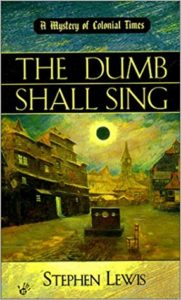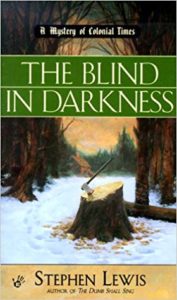Midwife Tales

What is it about the Puritans? From The Scarlet Letter to The Crucible, black-hatted, steely-eyed Puritans have been every author’s favorite villain. Puritanism itself is portrayed as an intolerant, joyless, self-satisfied religion of mealy-mouthed, slave-owning, protocapitalists. As a historian who studies these people, I spend much of my time battling these images. Indeed, over the years I have even developed a reluctant affection for the real Puritans, who fit some, but by no means all, of these literary stereotypes. Thus, it was with both hope and trepidation that I opened the first of Stephen Lewis’s three mystery novels set in seventeenth-century Massachusetts–hope that I would find a likable Puritan at last, and fear that I would not. I discovered that Lewis has written three decent detective stories, and has described the material conditions of life in early New England well enough. However, like his literary predecessors, Lewis has succumbed to the image of the villainous Puritan.
Catherine Williams, the main character and “detective” of these novels, is a sympathetic and likable character. She is a wealthy widow in Lewis’s fictional town of Newbury, Massachusetts, and like many real seventeenth-century widows, she lives an independent life. Catherine occupies a prominent position in Newbury as both a high ranking woman and the town’s midwife.
Catherine is a strong-willed and courageous woman who is not afraid to stand up to authority when she has to. When we meet Catherine in the first scene of The Dumb Shall Sing, she demonstrates this aspect of her character. A group of Pequot war captives are about to be executed and Catherine is there to bear witness. However, she is also there to see to an obligation made to her recently deceased husband: that one of the captives be spared and his fate left up to her. The gathered authorities object to the idea of a single woman making a decision regarding an unpredictable “savage,” but Catherine stands firm. She chooses the bravest of the Indians–a man named Massaquoit, who stood up to torture and humiliation with dignity and courage. By doing so, Catherine acquires an important ally and friend. Massaquoit’s special knowledge of Indian culture and local woodcraft are crucial to solving the three mysteries.
This first scene also introduces us to three other characters: Joseph Woolsey, the local magistrate, Minister Davis, and Governor Peters. Joseph is a good-hearted man who has been Catherine’s close friend for many years. Unlike Catherine, he is weak willed and unwilling to challenge others with whom he disagrees. Davis and Peters, on the other hand, are typical literary Puritans–self-righteous, greedy, racist, and cruel. It is the minister who gives the order to have Massaquoit’s fellow captives shot, and it is Governor Peters who objects the most strenuously to Catherine sparing one of the Indians. Both Peters and Davis act as Catherine’s nemeses, objecting to her independence and vigorously repressing all forms of dissent in Newbury.
This group of characters comes together in all three of the novels. True to the mystery genre, each plot revolves around a suspicious death. In the first book, The Dumb Shall Sing, Catherine’s role as midwife involves her in the case of Margaret Mary Donavan, an Irish servant girl accused of murdering a newborn baby placed in her care. The Blind in Darkness, number two in the series, begins with Catherine discovering the body of Isaac Powell, a recluse who lives only with a servant boy named Thomas. Massaquoit becomes the first and apparently most likely suspect. Finally, in The Sea Hath Spoken, Quakers arrive in Newbury. Roger and Jane Whitcomb immediately disturb services at the meeting house and soon become pariahs. Clouds of suspicion have already gathered around them when a local sailor drowns. Needless to say, the obvious suspects in each book are not the true villains, and Catherine plays a crucial role in bringing the real killers to justice. Each book provides enough plot twists and red herrings to keep a reader entertained until the end. One warning however: anyone who has read either Mary Beth Norton’s Founding Mothers and Fathers (New York, 1996) or Kathleen Brown’s Good Wives, Nasty Wenches and Anxious Patriarchs (Chapel Hill, 1996) will immediately recognize the true story on which The Blind in Darkness is based.
As historical novels, the books work well on one level. The material culture, foodways, and most of the medical details of Catherine’s midwifery practice are accurate. I was particularly pleased with the dialogue. Lewis manages to capture the texture of seventeenth-century language in a way that does not sacrifice intelligibility. Lewis has also clearly done his homework on quotidian details of colonial Massachusetts life. His knowledge of seventeenth-century firearms is extensive– I think I could almost fire a matchlock myself from Lewis’s detailed descriptions. Lewis’s depictions of childbirth capture both the atmosphere of the birthing room and the extent of midwives’ medical skills. While the historical details are for the most part accurate, there are a few anachronisms that an alert reader will notice. In general these do not detract from the story.
However, I could not overlook the biggest anachronism of all–that of character. Minister Davis and Governor Peters are caricatures, behaving in ways that even the sternest of real Puritans would have rejected. Even more disturbingly, Lewis succumbs to the trap of making all sympathetic characters models of twenty-first century tolerance and understanding. When the minister refers to Indians as bloodthirsty savages, Catherine replies that they are “Men. . . no more nor less, only without the benefit of your condition” (The Dumb Shall Sing, 4). Catherine also constantly questions her society’s values and her religion’s most basic doctrine–so much so that she sometimes seems more like a New Age spiritual advisor than a devout Puritan. Early in the first book, Lewis states that Catherine “depended on her intuitive understanding of the deity’s intention in a particular circumstance rather than on the applications of the minister’s sermons” ( The Dumb Shall Sing, 20). Passages such as these seem to come from the mistaken assumption that to be likable a character must share modern values, emotional reactions, and worldview.
And that is just what most disappointed me about these novels. I opened them hoping against hope that for once I would find a sympathetic Puritan character–one who accepts the values of his or her religion, who despises Quakers and fears Indians, but who is still understandable. While I did like Catherine Williams, she reminded me more of the nice nurse-midwife that lives down the street than of Anne Bradstreet or even Anne Hutchinson. Novelists have freedom that historians do not, and I long for one to create a Puritan that we can all appreciate and even love. I fear that I will just have to wait a while longer to find one.
This article originally appeared in issue 2.1 (October, 2001).
Rebecca J. Tannenbaum is an avid reader of both mysteries and historical novels. She is also the author of The Healer’s Calling: Women, Men, and Medicine in Early New England, forthcoming from Cornell University Press in 2002, and is a visiting assistant professor of history at Yale.


